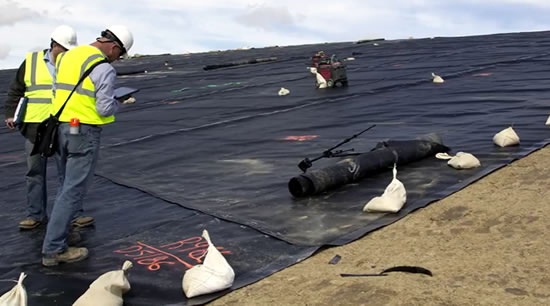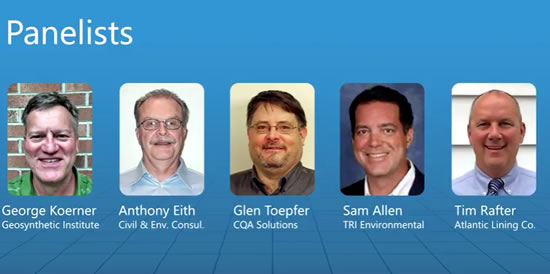At the open of promotional video for the March 28 geosynthetics panel discussion on failure and project value, the narrator quotes renowned investor Warren Buffet: Price is what you pay; value is what you get.
This is an especially apt comment for geosynthetics, where the decline of a simple quality assurance service can lead to millions of dollars of litigation, clean up, and repair due to failure.
The geosynthetics panel discussion will take place at SWANApalooza, which will be held March 27 – 31 in Reno, Nevada. The Solid Waste Association of North America is using the event to push training and more provocative forums.
GEOSYNTHETICS PANEL – WHAT IS THE COST OF FAILURE?

 In the March 28 Landfill Symposium session on “Getting What You Pay for from Design through Construction,” a top-flight geosynthetics panel will address the structure and deliverables that affect quality in completed construction of solid waste management projects.
In the March 28 Landfill Symposium session on “Getting What You Pay for from Design through Construction,” a top-flight geosynthetics panel will address the structure and deliverables that affect quality in completed construction of solid waste management projects.
Are you getting what you pay for? the session asks. What do you absolutely need to know? And: What is the cost of failure?
Large-scale failures of geosynthetic systems are not common, but the risk of failure increases whenever inexperienced installers and weld technicians are hired, testing isn’t properly conducted, materials are not handled responsibly, or experienced CQA is refused.
Joining the discussion will be:
- George Koerner, P.E., Director, Geosynthetic Institute
- Tim Rafter, Vice President of Business Development, Atlantic Lining Company, Inc.
- Glen Toepfer, President, CQA Solutions, Ltd.
- Sam Allen, Vice President. TRI Environmental
- Anthony W. Eith, P.E., Vice President, Civil & Environmental Consultants, Inc.
Joanna Toepfer will serve as moderator.
Topics and questions to be addressed by the geosynthetics panel include:
- Discussing the different segments of the quality structure pyramid which includes Owner Involvement & Accountability, Design & Specifications, Materials & Equipment, Vendor Management, Fieldwork, Regulatory Agency.
- Is Quality Assurance needed any more with the advancement of new technologies such as leak location liners?
- Current Industry Trends. Liner Installation in the landfill industry in particular has been called a “Race to the bottom” by several leading industry experts. Why is this? What can be done to stop it?
- Writing good specifications. If it is not in the specifications, don›t expect it to be done. Cut & Paste specifications.
- What education should be required for containment system design? Any field experience a prerequisite to design? Where does this education come from?
- What education/training should be required for field CQA personnel?
- What education/training should be required for installation personnel?
- What data should the field QA and installer be compiling on your project? Does the reviewing engineer or field QA look for and identify trends?
- There have been huge advancements in material quality, welding machines, and other methodology such as leak location surveys. Why do we still see the same problems we seen 20 years ago with these advancements?
WHY THIS IS IMPORTANT
Waste management is the mostly highly graded sector of the US infrastructure, as assessed by ASCE in its Report Card on American Infrastructure. This is largely thanks to the required uses of geosynthetics in landfill containment applications. The risk of failure or lesser performance/value remains, though, as new engineers come into the field and older sites may be pressured to commoditize services to trim short-term costs.
The need for experience may get overlooked due to historically strong interaction between the waste management and geosynthetics fields.
Dr. Ian D. Peggs of I-CORP International once found a ratio of 17:1 on the cost of repairing failures to the cost of what would have been preventative quality assurance measures. These included cases in which $5,000 – $20,000 in additional service or experienced oversight (on multi-million dollar sites) for a site were declined, sites which subsequently suffered failures and rebuild/litigation costs exceeding $500,000 or even $1,000,000.
A more dramatic example: Rebuilding TVA’s Kingston coal ash facility with a modern lining system would have cost between $20 and $25 million in the mid-2000s. Significantly lower cost drainage improvement were made. The site still failed, and the cleanup took years and well over $1 billion.
The issue extends beyond waste management. In the mining sector, Glen Toepfer has calculated the millions of dollars that mining sites lose on their potential ore yield over the life of an operation by not properly selecting or using proper CQA for heap leach lining systems up front. Those figures do not consider the potential environmental costs associated with site leakage.
GET INVOLVED
Take part in the SWANApalooza session on March 28. Learn more and register online.
View the full SWANApalooza program here (PDF)











